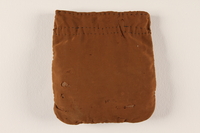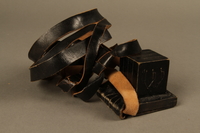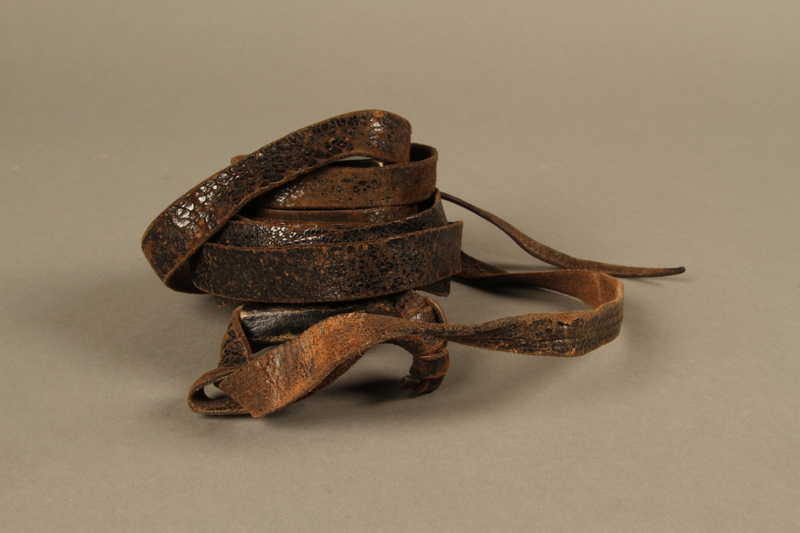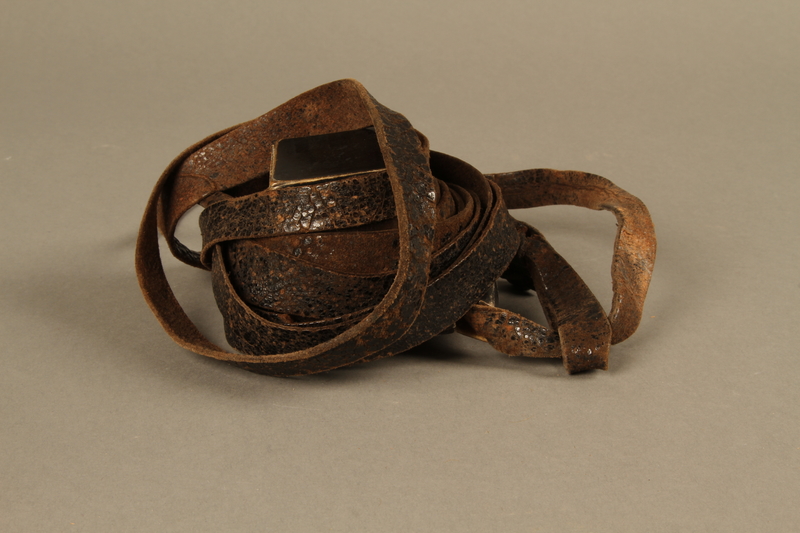Overview
- Brief Narrative
- Hand tefillin worn by Israel Miedzyrzecki to store his tefillin, which he kept with him while imprisoned in the Warsaw ghetto from 1940 to 1942 and in hiding from 1942 to 1945. Tefillin are small boxes containing prayers attached to leather straps and worn on the arm and the head by Orthodox Jewish males during morning prayers. Israel and his family, wife Rivka, and children Stela, Benjamin, Mordecai, and Genia, lived in Warsaw during the German occupation which began in September 1939. They were forced into the Jewish ghetto in October 1940. In July 1942, the Germans began mass deportations of Jews to Treblinka killing center. Israel was arrested in September, but bribed a policeman to return home. Stela and her husband Yitzhak Blachowicz were sent to Treblinka. In late 1942, Benjamin, who was in the resistance, persuaded Israel, Rivka, and Genia to join him in hiding outside the ghetto. In summer 1943, Mordecai was killed by the Germans. During the Warsaw Polish Uprising, August -October 1944, Israel, Rivka, and Genia were separated from Benjamin. They went to Opoczno, and lived with a Polish family. They sent a message to Benjamin through the underground, and the family was reunited after the liberation of Warsaw on January 16, 1945. They lived in Warsaw, where Israel insisted that Benjamin marry Feigele (Vladka) Peltel, a resistance fighter and his companion during the war. The family went to Łódź and after the war ended in early May 1945, left for Munich, Germany. In May 1946, Benjamin and Feigele sailed for America. Genia emigrated to Palestine in 1946 and Israel and Rivka joined her in 1947.
- Date
-
use:
before 1939-1980
- Geography
-
use:
Warsaw (Poland)
use: Israel
- Credit Line
- United States Holocaust Memorial Museum Collection, Gift of Benjamin Meed in honor of his father Israel Miedzyrzecki (Nahari)
- Contributor
-
Subject:
Israel Y. Nahari
Subject: Benjamin Meed
- Biography
-
Israel Yitzhak Miedzyrzecki was born on February 13, 1892, in Warsaw, Poland, to Berisch and Feiga Halberstadt Miedzyrzecki. He had 8 siblings and a large extended family. Israel was a tanner. He married Rivka Rybak, who was born on May 30, 1896, in Warsaw. They had four children: Stela, born 1916; Benjamin, born February 19, 1918; Mordecai, born 1922; and Genia, born May 21, 1934. Israel and Rivka spoke Yiddish and their children spoke Yiddish and Polish. Rivka was in poor health and they had a nanny for the children. The family was Orthodox. In 1937, Jewish ritual slaughter was severely limited and Israel no longer purchased meat for the family, refusing to allow non-Kosher meat in the household. In 1939, Israel’s son Mordecai planned to emigrate to the United States. Israel and Rivka were ashamed that Mordecai would leave and asked him to stay, so he did.
On September 1, 1939, Germany invaded Poland. The city was bombed and the family hid in the basement. Warsaw resisted occupation until September 29. Israel’s son Benjamin got bread from the German soldiers because he did not appear Jewish and spoke unaccented Polish, unlike the rest of the family. Around October, Benjamin and a friend fled to eastern Poland. The Germans persecuted Jews and separated them from Polish society. On November 23, Jews had to wear Star of David armbands. Jews received less rations than Polish people and their stores were closed. Israel hid his leather so it would not be taken. His son Benjamin returned in December. Israel had been reluctant for Benjamin to leave but was unhappy that he returned. The ghetto was established on October 12, 1940, and sealed in November. Their apartment was already located in the ghetto and several people moved in with them. The ghetto was overcrowded and they had very little food. In late 1940, Israel’s son Benjamin became a forced laborer. He left the ghetto for work and took clothes to trade for food. Israel’s daughter Stela married Yitzhak Blachowicz in a traditional Jewish wedding. From July 22 to September 12, 1942, the Germans took thousands of Jews out of the ghetto. In September, Israel was arrested and taken to Umschlagplatz. His daughter Stela, who worked as a secretary for a leader in the Judenrat (Jewish Council), tried to help him but was arrested and taken away with her husband Yitzhak. Israel bribed a policeman and was let go.
In late 1942, Benjamin left the ghetto and went into hiding. Benjamin and a neighbor, Ziferman, convinced Israel, Rivka, and Genia to leave the ghetto and go into hiding on the Aryan side in late 1942. Israel would only go on the condition that he could bring his tallis and tefillin. Israel’s son Mordecai stayed behind, working for the Tobbens factory in the ghetto. Around January 1943, Mordecai was taken to Poniatowa, when the Tobbens factory was moved. A Polish woman helped Mordecai escape and return to his family. Benjamin found a new hiding place for the family, in a cemetery in Praga, across the Vistula River. Benjamin, who built hiding places for the resistance, constructed a false wall in the cemetery’s goat shack they could stand behind during the daytime. Benjamin was gone during the days with his girlfriend, Feigele (Vladka) Peltel, a resistance courier. At night, the cemetery caretaker allowed them stay in his home on the grounds. Every Friday night, Rivka lit candles for Shabbat. On April 19, 1943, the Warsaw Ghetto Uprising began. Armed Jews in the ghetto resisted deportations, but the Germans crushed the resistance and killed and deported thousands of Jews. Israel and his family could see the ghetto burning. The uprising ended on May 16 and the ghetto was left in ruins.
In summer 1943, Benjamin acquired a false Latin American visa with the help of Israel and a family friend and gave it to Mordecai. Mordecai disappeared and they learned he was shot. On August 1, 1944, the Warsaw Uprising began. The Polish Home Army saw Soviet troops across the Vistula and rose against the Germans. Benjamin was afraid that his family would be killed if they remained in Praga, because the cemetery was located between 2 factories that he believed would be bombed. He moved them across the river to a new hiding place in Warsaw and left to be with Feigele. The Soviets advanced to the Vistula and liberated Praga, but did not cross the river into Warsaw, so the Uprising was crushed and Israel and his family were not liberated. They lost contact with Benjamin. They left Warsaw and went to Opoczno, where they stayed with a Polish family who did not know they were Jewish. Israel did not speak Polish well and would have been discovered as a Jew, so his daughter Genia went to the marketplace and found a woman who Genia thought was Jewish. In mid-January 1945, the woman sent word through the resistance that the Miedzyrzecki family was looking for Benjamin. After Benjamin was liberated on January 16, he went to Opoczno and found them.
They returned to Warsaw, where Israel insisted that Benjamin and Feigele were married. Israel went to Lublin and found one of his brothers, who told him many of their relatives were still alive. Israel’s daughter Stela and her husband had been sent to Treblinka and killed. The family moved to Łódź and opened a leather store. The war ended when Germany surrendered on May 7. After hearing of renewed pogroms on Jews, they decided to leave Poland. In summer 1945, Benjamin and Feigele left for Belgium. In fall 1945, Israel, Rivka, and Genia met Benjamin and Feigele in Munich. Benjamin and Feigele emigrated to the United States in May 1946. Israel and Rivka decided not to go with them. Genia emigrated to Israel in 1946. Israel and Rivka joined her in approximately 1947. They settled in Tel Aviv and changed their last name to Nahari. Israel died in approximately 1980.
Benjamin Miedzyrzecki was born on February 19, 1918, in Warsaw, Poland, to Israel and Rivka Rybak Miedzyrzecki. He had three siblings: Stela, born 1916; Mordecai, born 1922; and Genia, born May 21, 1934. Israel was born on February 13, 1892, and was a tanner. Rivka was born on May 30, 1896. They spoke Yiddish and Polish. Benjamin attended an Orthodox Hebrew school until fifth grade, then went to a public school, where he immersed himself in Polish culture and learned to speak flawless Polish. In 1939, Benjamin’s brother Mordecai planned to emigrate to the United States. Their parents were ashamed that Mordecai would leave and asked him to stay, so he did.
On September 1, 1939, Germany invaded Poland. Warsaw resisted occupation and Benjamin made barricades in the streets. On September 29, German troops entered Warsaw. The German soldiers gave bread to Polish people, but pushed Jews away. They gave Benjamin bread because with his light hair and blue eyes, he did not appear Jewish. Around October, Benjamin and a friend fled to Bialystok, then Brest-Litovsk (Brest, Belarus). His friend wanted to go home, so they returned to Warsaw in December. In early 1940, Benjamin joined the underground resistance. He was in a group of six that operated an illegal library. The ghetto was established on October 12, 1940, and sealed in November. Benjamin’s apartment was already located in the ghetto and several people moved in with them. The ghetto was overcrowded and they had very little food. Benjamin arranged a school for the children in his building and taught at night. In late 1940, Benjamin became a forced laborer. He left the ghetto every day to pick up bricks from destroyed buildings. Benjamin took clothing out of the ghetto and traded it for food to bring back to his family. The resistance asked him to smuggle people in and out of the ghetto with the labor brigade. From July 22 to September 12, 1942, the Germans took thousands of Jews out of the ghetto. In September, Benjamin’s father Israel was arrested and taken to Umschlagplatz. Benjamin’s sister Stela, who worked as a secretary for a leader in the Judenrat (Jewish Council), tried to help him but was arrested with her husband Yitzhak Blachowicz and sent to Treblinka. Israel bribed a policeman and was let go. Following the mass deportations, the resistance asked Benjamin to build hiding places in the ghetto.
Later that fall, Benjamin met Feigele (Fajga) Peltel, called Vladka by the resistance. Feigele’s father died of pneumonia in the ghetto in 1941 and her mother, brother, and sister were deported in August 1942. She was a courier for the resistance and asked Benjamin to smuggle her out of the ghetto. He agreed, not knowing she was carrying a diagram of Treblinka. She was stopped and searched but was let go when someone else tried to run. In late 1942, Benjamin left the ghetto and stayed with a Polish woman named Juliana Larisz. He assumed the name Czeslaw Pankiewicz. He arranged to meet Feigele. The couple began dating, but had to keep their relationship a secret from the resistance. In late 1942, Benjamin convinced Israel, Rivka, and Genia to leave the ghetto with him and go into hiding. His brother Mordecai stayed, working for the Tobbens factory in the ghetto. In approximately January 1943, Mordecai was taken to Poniatowa, when the Tobbens factory was moved. A Polish woman helped Mordecai escape and join his family. Juliana helped Benjamin find a new hiding place for his family, in a goat shack in a cemetery in Praga, across the Vistula River.
After the mass deportations in summer 1942, people in the ghetto prepared to resist further deportations. Feigele purchased weapons and smuggled them into the ghetto. On April 19, 1943, the Warsaw Ghetto Uprising began. Armed Jews in the ghetto resisted deportations, but the Germans crushed the resistance and killed and deported thousands of Jews. Benjamin and other resistance members posted signs proclaiming solidarity with the fighters throughout Warsaw. Benjamin and his family witnessed the ghetto burning. The uprising ended on May 16 and the ghetto was left in ruins. In summer 1943, Benjamin acquired a false Latin American visa with the help of Israel and a family friend. Mordecai asked Benjamin to give him the document and he agreed. Mordecai disappeared and they learned he was shot. Benjamin continued to work for the resistance, building hiding places and waiting for Feigele to return from her daily courier missions.
On August 1, 1944, the Warsaw Uprising began. The Polish Home Army saw Soviet troops across the Vistula and rose against the Germans. Benjamin was afraid that his family would be killed if they remained in Praga, because the cemetery was located between 2 factories that he believed would be bombed. He moved them across the river to a new hiding place in Warsaw and left to be with Feigele. The Soviets advanced to the Vistula and liberated Praga, but did not cross the river into Warsaw, so the Uprising was crushed and Israel and his family were not liberated. Benjamin lost contact with his family. The wounded were being evacuated, so Benjamin bandaged his head and a Polish peasant took him and Feigele out of the city. They went to Pruszkow for a short time, then left to find a Jewish friend hiding on a farm near Kurczowa Wies. The estate had been taken over the German army, but they had false papers. In mid-January 1945, a member of the resistance told Benjamin that his family was in Opoczno and looking for him. On January 16, Benjamin and Feigele were liberated by Soviet troops in Kurczowa Wies.
Benjamin went to Opoczno and found his family. They returned to Warsaw, where Benjamin and Feigele were married. The family moved to Łódź and opened a leather store. The war ended when Germany surrendered on May 7, 1945. After hearing of renewed pogroms on Jews, Benjamin and Feigele decided to leave Poland, first to Belgium, then the US. In summer 1945, the couple was caught on the Belgian border by the British and imprisoned in Aachen. After a month, they were released by a British rabbi. They were very malnourished and were sent to recuperate in Garmisch-Partenkirchen. In August 1945, they moved to Munich and were joined by Benjamin’s family. On May 13, 1946, Benjamin and Feigele boarded the SS Marine Perch in Bremerhaven, arriving in New York on May 23. They settled in New York. Israel, Rivka, and Genia emigrated to Palestine in 1946. Feigele, who was famous for her activity in the resistance, wrote for a Jewish newspaper, The Forward. Benjamin opened an import-export business. They had two children. When they became naturalized American citizens in 1952, they changed their names to Benjamin and Vladka Meed. They were leaders in the survivor community and helped found the Warsaw Ghetto Resistance Organization, the World Gathering of Jewish Holocaust Survivors in Jerusalem, the American Gathering of Jewish Holocaust Survivors in DC, and the Registry of Jewish Holocaust Survivors. Benjamin helped found the United States Holocaust Memorial Museum and the Museum of Jewish Heritage. Benjamin, age 88, died on October 24, 2006, in New York. Vladka, age 90, died on November 21, 2010.
Physical Details
- Language
- Hebrew
- Classification
-
Jewish Art and Symbolism
- Category
-
Jewish ceremonial objects
- Object Type
-
Tefillin (lcsh)
- Physical Description
- Square black painted leather box centered on a slightly larger black painted square, layered leather platform, with a dark brown leather strap inserts through the platform, and knotted on one end. The box contains a parchment scroll inscribed with 4 Torah verses.
- Dimensions
- overall: Height: 2.125 inches (5.398 cm) | Width: 2.250 inches (5.715 cm) | Depth: 2.125 inches (5.398 cm)
- Materials
- overall : wood, leather, parchment, ink
Rights & Restrictions
- Conditions on Access
- No restrictions on access
- Conditions on Use
- No restrictions on use
Keywords & Subjects
- Topical Term
- Holocaust, Jewish (1939-1945)--Poland--Warsaw--Personal narratives. Holocaust survivors--Israel--Biography. Holocaust survivors--United States--Biography. Jews--Poland--Warsaw--Biography. World War, 1939-1945--Jewish resistance--Poland--Warsaw--Personal narratives. World War, 1939-1945--Underground movements--Poland--Warsaw--Personal narratives, Jewish.
- Geographic Name
- Poland--History--Occupation, 1939-1945--Biography.
- Personal Name
- Meed, Benjamin, 1918-2006.
Administrative Notes
- Legal Status
- Permanent Collection
- Provenance
- The tefillin was donated to the United States Holocaust Memorial Museum in 1995 by Benjamin Meed, the son of Israel (Miedzyrzecki) Nahari.
- Funding Note
- The cataloging of this artifact has been supported by a grant from the Conference on Jewish Material Claims Against Germany.
- Record last modified:
- 2024-02-26 12:04:58
- This page:
- https://collections.ushmm.org/search/catalog/irn9875
Download & Licensing
In-Person Research
- By Appointment
- Request 21 Days in Advance of Visit
- Plan a Research Visit
- Request to See This Object
Contact Us
Also in Israel (Miedzyrzecki) Nahari collection
The collection consists of a set of tefillin and a tefillin pouch used by Israel Miedzyrzecki (later Nahari) before the Holocaust in Warsaw, Poland, during the Holocaust in the Warsaw ghetto and in hiding, and after the Holocaust in Israel.
Date: before 1939-1980

Brown tefillin pouch used by a Polish Jewish man in the Warsaw ghetto and in hiding
Object
Brown cloth pouch used by Israel Miedzyrzecki to store his tefillin, which he kept with him while imprisoned in the Warsaw ghetto from 1940 to 1942 and in hiding from 1942 to 1945. Tefillin are small boxes containing prayers attached to leather straps and worn on the arm and the head by Orthodox Jewish males during morning prayers. Israel and his family, wife Rivka, and children Stela, Benjamin, Mordecai, and Genia, lived in Warsaw during the German occupation which began in September 1939. They were forced into the Jewish ghetto in October 1940. In July 1942, the Germans began mass deportations of Jews to Treblinka killing center. Israel was arrested in September, but bribed a policeman to return home. Stela and her husband Yitzhak Blachowicz were sent to Treblinka. In late 1942, Benjamin, who was in the resistance, persuaded Israel, Rivka, and Genia to join him in hiding outside the ghetto. In summer 1943, Mordecai was killed by the Germans. During the Warsaw Polish Uprising, August -October 1944, Israel, Rivka, and Genia were separated from Benjamin. They went to Opoczno, and lived with a Polish family. They sent a message to Benjamin through the underground, and the family was reunited after the liberation of Warsaw on January 16, 1945. They lived in Warsaw, where Israel insisted that Benjamin marry Feigele (Vladka) Peltel, a resistance fighter and his companion during the war. The family went to Łódź and after the war ended in early May 1945, left for Munich, Germany. In May 1946, Benjamin and Feigele sailed for America. Genia emigrated to Palestine in 1946 and Israel and Rivka joined her in 1947.

Head tefillin worn by a Polish Jewish man in the Warsaw ghetto and in hiding
Object
Head tefillin worn by Israel Miedzyrzecki to store his tefillin, which he kept with him while imprisoned in the Warsaw ghetto from 1940 to 1942 and in hiding from 1942 to 1945. Tefillin are small boxes containing prayers attached to leather straps and worn on the arm and the head by Orthodox Jewish males during morning prayers. Israel and his family, wife Rivka, and children Stela, Benjamin, Mordecai, and Genia, lived in Warsaw during the German occupation which began in September 1939. They were forced into the Jewish ghetto in October 1940. In July 1942, the Germans began mass deportations of Jews to Treblinka killing center. Israel was arrested in September, but bribed a policeman to return home. Stela and her husband Yitzhak Blachowicz were sent to Treblinka. In late 1942, Benjamin, who was in the resistance, persuaded Israel, Rivka, and Genia to join him in hiding outside the ghetto. In summer 1943, Mordecai was killed by the Germans. During the Warsaw Polish Uprising, August -October 1944, Israel, Rivka, and Genia were separated from Benjamin. They went to Opoczno, and lived with a Polish family. They sent a message to Benjamin through the underground, and the family was reunited after the liberation of Warsaw on January 16, 1945. They lived in Warsaw, where Israel insisted that Benjamin marry Feigele (Vladka) Peltel, a resistance fighter and his companion during the war. The family went to Łódź and after the war ended in early May 1945, left for Munich, Germany. In May 1946, Benjamin and Feigele sailed for America. Genia emigrated to Palestine in 1946 and Israel and Rivka joined her in 1947.







